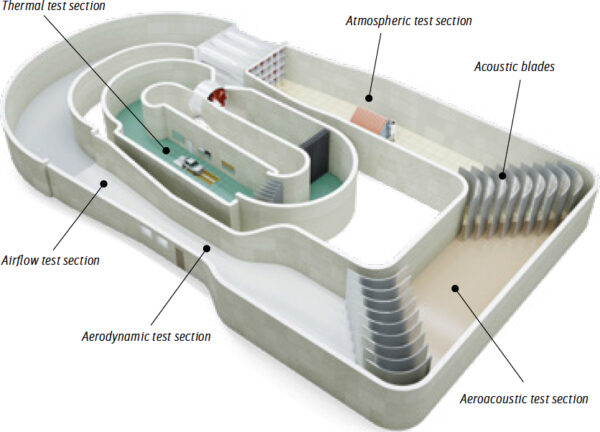Services currently offered by the infrastructure:
The JVCWT can reproduce at full scale, the different atmospheric parameters; laminar and turbulent wind, rain, dust, sand, in the Dynamic Unit SC1, and wind, fog, rain, snow, solar radiation in a thermally controlled environment of the Thermal Unit SC2. The control of the different climatic variables permits fine parametric studies of their influence, which is not possible in the real outdoor conditions. Many applications linked to environmental, building and transport issues or safety can thus be rapidly studied.
A wide range of current and emerging topics in European applied research require a facility like JVCWT. About 10 to 20 European teams (outside France) per year are making use of the wide versatility of JV facility to address topics such as:
- Static and dynamic effects of wind on structure elements at full scale;
- Wind stability of slender structure elements;
- Building components in rain or snow conditions.;
- Snow loads on buildings (and snow ingress in air-inlets);
- Thermal behaviour of buildings systems;
- Climatic behaviour of sensors embedded in structures;
- Comfort in adverse climatic situations.
DESCRIPTION OF WORK:
Modality of access under this proposal:
It is expected that a typical experimental program lasts between five and eight days. Hence, the actual experimental work will be planned 4 to 6 months in advance. The regular work schedule of the facility is usually planned at least 3 months in advance. The early scheduling of the experimental period of users under this project will avoid the risk.
Before the experimental period, a preliminary meeting is organized at the facility to discuss both the practical research program schedules and the technical requirements to achieve the goals of the users. All necessary equipment and human resources of the facility are pre-booked during this meeting to alleviate the risks of unavailability due to other project implementation. The preparatory meeting is part of the project.
For both wind tunnel units, i.e., dynamic unit SC1 or thermal unit SC2, the unit of access offered in this project is a day. The access offered covers the use of the facility and regular operators of the facility (technical staff required to operate the facility). It also includes full support from technical engineers of CSTB to set up the experimental measurements and acquisition system. Providing the instructions regarding models or mock-ups necessary to carry out the research work are under the responsibility of the users. The unit access includes the support of the technical staff to make the model and adapt it to the specific environment of the facility. It also includes all available resources of CSTB workshops (milling machine, metal lathe, numerical command workshop tools) to adapt or repair the model during the test period.
For both wind tunnel units, i.e., dynamic unit SC1 or thermal unit SC2, the access cost is based on the actual cost.
Support offered under this proposal:
The test programs achieved in the JVCWT are set-up in close collaboration with the visiting users of the facility.
The various and high level of qualification of the JVCWT staff is a guarantee for the users who can rely on it in the field of aerodynamics, climatic or thermal sciences and also for more technical matters such as measurements, instrumentation, electronics and computer sciences.
CSTB staff involved in any research project is chosen according to the expertise in the studied theme. The CSTB staff fully contributes to the research program implementation and the associated scientific discussion. All tools of the facilities, necessary to undertake the experimental programs, are made available along with human assistance: i.e., engineers and technical assistants according to needs. Computational resources, electronic and mechanical workshops of CSTB are available for adaptation of the test equipment brought by the users.
The working language is English or French. If required, visiting scientists can have their travel and living arrangements prepared by CSTB. Within the facility premises, a desk office (with telephone, fax, computer, web services, etc.) is made available for users.
The test programs are under the responsibility of the head of CAPE Department (Climatology Aerodynamics, Pollution and Purification) of CSTB Nantes or the project manager he delegates. All instrumentation and test models, which do not belong to CSTB, are protected by insurance in case of accidental destruction.
JVCWT is in the vicinity of Nantes University and benefits from the scientific links set-up with academic researchers (Ecole Centrale de Nantes, Ecole des Mines, Université de Nantes). This also gives opportunities to students to be involved in research work at JVCWT for training periods.
The CSTB provides strong links through the French scientific and engineering community and through their links to the central government.
Review procedure under this proposal:
For details on the TA evaluation process, please refer to Task 1.2 of WP1 and the process followed by the TA-SEP in particular.


